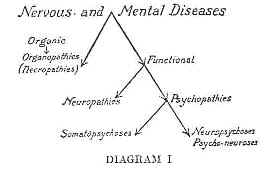| Boris
Sidis Archives Menu
Table
of Contents
Next Chapter
CHAPTER VII FORMS OF NEUROSIS A brief outline of a classification of nervous and mental diseases, made by me in my various works, may be of help towards a clear understanding of neurotic disturbances. The different forms of nervous and mental diseases may be classified into Organic and Functional. By organic affections I mean to indicate pathological modifications of the neuron and its processes taking place in the very structure (probably the cytoreticulum) of the nerve cell. Under this category come such maladies as general paresis, dementia praecox, all mental and nervous affections of a degenerative and involutionary character. Such diseases are termed by me Organopathies, or Necropathies. By functional affections I mean to indicate all neuron changes in which the functions of the neuron and its reactions to external and internal stimulations are involved in the pathological process without, however, affecting the anatomical structure of the nerve cell. The pathological changes are not permanent,―recovery of normal function is possible with the restitution of favorable conditions of nutrition and elimination. Functional nervous and mental diseases are in turn subdivided into Neuropathies and Psychopathies. Neuropathic diseases are disturbances of functioning activity, due to defective neuron matabolism, brought about by external stimuli, and more specially by harmful internal stimuli―glandular secretions, hormones, toxic and autotoxic agencies. The pathological, neuropathic process produces few, if any anatomical, changes in the structure of the neuron. The pathology of neuropathic diseases, probably of the cytoplasm) is essentially chemico-physiological in nature. Neuropathic diseases include maladies in which the neuron undergoes degenerative changes. At first there is an apparent increase, then an inhibition, and finally a complete suspension of neuron function, not terminating in the destruction of the neuron. Neuron restitution is possible. Such affections are produced by mild poisons, organic, or inorganic, by autotoxic products, by hyposecretion or hypersecretion, or by absence of hormones in the economy of the organism. Here belong all the temporary, or recurrent maniacal, melancholic, delusional states, puerperal mania, epileptic insanity, the mental aberrations of adolescent and climacteric periods, periodic insanity, alternating insanities, and in general all the mental affections known under the description of manic-depressive insanity. Where the disease depends on the interrelation of neurons in a complex group, on association of systems of neurons, the condition is psychopathic in nature. In psychopathic troubles the neuron itself may remain unaffected, may be perfectly normal and healthy. The disorder is due to association with systems of neurons which are usually not called into action by the function of that particular neuron system. By Organopathies or Necropathies I indicate a group of psychophysiological symptoms, accompanied by structural, necrotic changes of the neuron, terminating in the ultimate death of the neuron systems, involved in the pathological process. By Neuropathies I indicate a group of psycho-physiological manifestations due to pathological functional neuron modifications, capable of restitution through normal metabolism. By Psychopathies I designate pathological phenomena of psychophysiological dissociation and disaggregation of neuron systems and their functions in clusters, the neuron itself and its special function remaining undamaged. The psychopathies are further subdivided into Somatopsychoses and Psychoneuroses or Neuropsychoses. The somatopsychoses are characterized by somatic symptoms, by disturbances of bodily functions, such as paralysis, contractures, convulsions, anesthesia, analgesia, hyperalgesia, and other sensory disturbances, as well as by intestinal, cardiac, respiratory, and genito-urinary troubles. The psychoneuroses or Neuropsychoses are characterized by mental symptoms. The patient's whole mind is occupied with mental troubles. Such conditions are found in obsessions, fixed ideas, imperative impulses, emotional compulsions, and other allied mental and nervous maladies. Somatopsychoses simulate physical and organic nervous troubles. Thus, many "hysterical" forms simulate tabes, or paralysis agitans, hemiplegia, paraplegia, or epilepsy, while many of the neurasthenic, hypochondriacal, and their allied states may simulate tumor, cancer, intestinal and glandular derangements, cardiac, laryngeal, pneumonic, hepatic, splanchnic ovarian, tubal, uterine, renal, and other bodily afflictions. The neuropsychoses or psychoneuroses simulate all forms of mental disease, beginning with melancholia and mania, and ending with general paresis and dementia. Psychoneurosis and somatopsychosis are diseases of the subconscious; in the former mental, in the latter physical symptoms predominate. Psychopathic states should be rigidly differentiated from other disturbances, such as neuropathies organopathies, or necropathies. The following diagram may be of help:
|
